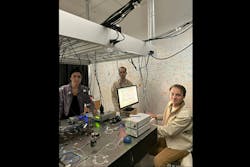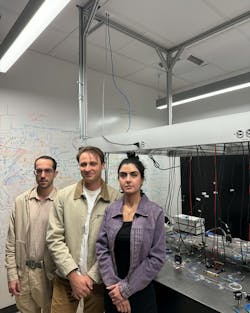A new approach by a team of University of Southern California (USC) researchers uses simple thermodynamics principles to route light within nonlinear systems—no switches, external control, or digital addressing required. Instead of suppressing nonlinear dynamics, this self-organized behavior can be harnessed for adaptive photonic devices to let light route itself.
It’s a breakthrough that may enable chips to process information much more efficiently (see video).
“Modern photonics has reached an extraordinary level of control over light within single-mode systems, powering technologies such as fiber-optic networks, precision lasers, and integrated photonic circuits,” says Mercedeh Khajavikhan, a professor of electrical and computer engineering, as well as physics and astronomy at USC, whose Optics & Photonics Group led this work. “But as we push toward higher powers, broader bandwidths, and denser information channels, light inevitably enters multimode and nonlinear regimes where traditional design principles must be reconsidered. Within these regimes, light behaves less like a single wave and more like a ‘many-body’ system—its dynamics are shaped by complex interactions among a vast number of modes.”
Attempting to describe such behavior through conventional electrodynamics or coupled nonlinear equations quickly becomes impractical and offers little intuition about how the system as a whole evolves. “This realization led us to approach light from a different angle: Not through a deterministic description of the field’s individual trajectories, but as a statistical ensemble governed by collective rules,” says Demetri Christodoulides, a professor of electrical and computer engineering at USC who co-led the project. “From this perspective emerged the concept of optical thermodynamics—a framework for understanding and harnessing the self-organizing behavior of light within complex, nonlinear, highly multimode environments.”1-3
Nonlinearity plays a central role in the team’s approach. “While linear systems confine light to a predetermined spectral evolution, nonlinearity introduces new degrees of freedom, enabling energy exchange and interaction across modes,” Christodoulides explains. “But these same interactions can make the system highly chaotic and unpredictable. Optical thermodynamics provides the missing link—a way to describe the statistical equilibrium of such nonlinear systems, much like how gases reach equilibrium through energy exchange among ‘particles.’”
This way of thinking revealed something remarkable: Light can self-organize within a nonlinear medium. “It can find its own pathway—not through external control or feedback, but through intrinsic thermodynamic evolution,” says Khajavikhan. “This insight guided our exploration of universal light funneling, where light, regardless of its initial conditions, naturally redistributes itself into a stable, localized output state.4 It’s a step toward a new way of controlling light—one that relies not on precision engineering, but on the fundamental statistical laws that govern complex systems.”
Background basics
Within a linear multimode system, each optical mode acts as an isolated channel. Once power is injected into a mode, it remains confined there indefinitely. This is the defining property of a mode, but it breaks down within nonlinear multimode systems where modes interact and exchange energy. Nonlinearity couples the modes, which allows power launched into one of them to dynamically redistribute among many others.
When hundreds or thousands of modes participate, the process becomes exceedingly complex—each mode’s evolution depends on the instantaneous power distribution across the entire system. “Tracking every interaction is neither practical nor insightful. Instead, optical thermodynamics approaches the problem statistically, describing not individual field trajectories but the ensemble of possible energy configurations,” says Khajavikhan. “Each configuration—each way energy can be shared among modes—represents a microstate, and the number of accessible microstates determines the system’s entropy. The system naturally evolves toward states that can be manifested in the largest number of ways—those of maximum entropy.”
An analogy is “distributing a fixed amount of energy among oscillators of different frequencies—there are far more ways to allocate this energy among many low-frequency oscillators than among a few high-frequency ones,” says Christodoulides. “Consequently, equilibrium favors heavily populated low-frequency modes, giving rise to the familiar Rayleigh-Jeans distribution. Optical thermodynamics extends this statistical logic to light, linking the nonlinear dynamics of multimode propagation to the universal tendency of complex systems to maximize entropy.”
This realization led to the development of a comprehensive framework of optical thermodynamics, through which the behavior of light within complex multimode systems can be characterized using a few macroscopic parameters—such as optical temperature, chemical potential, and thermodynamic pressure.
“Most importantly, this framework allows us to think about light evolution and flow in terms of thermodynamic processes rather than microscopic dynamics,” says Khajavikhan. “Like an ideal gas, where we can describe energy flow from regions of high to low temperature or pressure without tracking the motion of each molecule, we can describe the redistribution of optical energy through simple, universal laws. In this way, optical thermodynamics provides a powerful bridge between nonlinear optics and statistical physics to reveal that even highly complex optical systems obey elegant, predictable thermodynamic principles.”
A universal form of optical routing
Building on the principles of optical thermodynamics, the team designed a system in which two thermodynamic processes unfold as light propagates through a nonlinear multimode medium—enabling a universal form of optical routing not possible within other conservative systems.
“Our first process is closely analogous to the Joule-Thomson (JT) effect5—the same principle that enables cooling machines to cool a gas during expansion,” explains Georgios Pyrialakos, a postdoctoral researcher at USC within Christodoulides’ group. “In nonideal gases, cooling arises from the exchange of energy between kinetic and potential components as it expands through a valve. In our optical implementation, light is injected into one of the input channels of a lattice. As it propagates, the initially confined beam begins to experience the entire lattice and expands into many waveguides—and reduces its effective temperature. In the language of optical thermodynamics, this corresponds to the optical power gravitating toward the lower-order modes of the array.”
And the second phase corresponds to the thermalization of light, during which the beam relaxes into lower-order modes as dictated by the Rayleigh-Jeans law—the optical analogue of energy sharing among particles in an ideal gas. “To enable universal routing where light ends up in a single site, in this work we designed the lattice so that the lowest-order modes—representing the lowest energy states—are spatially localized toward one side and around a single site,” says Khajavikhan. “This is the case in an array with triangular index detuning.”
Together, these two stages—JT-like optical cooling followed by mode thermalization—drive light to self-localize into a single output channel. The process requires no external control or feedback; it’s driven entirely by the system’s own thermodynamic evolution.
“Experimentally, we achieved this behavior on a time-synthetic photonic mesh lattice, where the lattice sites correspond to discrete time bins of optical pulses,” says Hediyeh Mohammadi Dinani, a Ph.D. student within Khajavikhan’s Optics and Photonics Group, who ran the experiments. “By carefully controlling the nonlinear coupling and dispersion landscape, we observed the spontaneous redistribution of optical energy and the emergence of a localized output—a direct manifestation of light organizing itself through thermodynamic principles.”
Simplify the design process
The team realized that to truly understand and control these systems, they had to move beyond traditional design approaches based on exact or numerical solutions of the nonlinear Schrödinger or optical evolution equations, and instead view them through a statistical and thermodynamic framework.
“Remarkably, this shift in perspective simplifies the design process: Once the flow of power within the system is understood, achieving a desired behavior requires only minimal adjustments to the linear array or to the way power is coupled into it,” says Khajavikhan. “This opens an immense, unexplored landscape filled with opportunities to uncover entirely new and unexpected optical behaviors.”
A striking moment occurred for the team when they observed that light didn’t need to be guided—it found its own path. No matter which input port they excited, the beam always funneled into the same localized state. “Witnessing this universal behavior emerge experimentally was both surprising and deeply satisfying,” says Dinani. “Our true ‘aha!’ moment was realizing that light could propagate in a highly confined manner through a nonlinear medium with minimal diffraction—it felt as if the system was making a decision on its own, which is an elegant reminder that under the right conditions physics naturally finds simplicity within complexity.”
The beauty of thermodynamics “lies within its macroscopic nature—it abstracts away the microscopic complexity and reveals how collective behavior emerges from countless underlying interactions,” says Khajavikhan. “In doing so, it allows us to perceive a system almost as a living entity, endowed with its own form of self-organization and evolution. Thermodynamics provides an intuitive framework for understanding how energy, entropy, and temperature shape the flow of a system toward equilibrium or drive it into new regimes of order. This perspective transforms our view: Rather than analyzing individual trajectories or field equations, we witness the system’s global tendencies—how it redistributes energy, stabilizes, or spontaneously transitions into new states. It gives us a sense of the system ‘breathing,’ evolving in a way that feels alive.”
Complex challenges
The proof-of-principle confirmation of the underlying physics must be carried out in a way to ensure observed results truly correspond to the proposed concept. “Achieving stable operation within a time-synthetic nonlinear lattice presents technical challenges,” says Dinani. “Our experiment requires precise synchronization between circulating optical pulses and external modulators, as even small drifts can disrupt pulse evolution and obscure the lattice dynamics.”
Operating deep within the nonlinear regime adds further complexity, because unwanted instabilities and pulse decoherence must be carefully avoided. “Maintaining this delicate balance was essential to achieve controlled conditions and clearly observe the light-funneling phenomenon,” Dinani says.
A new frontier in optics and photonics
This work opens a new frontier in optics and photonics “by demonstrating that complex functionalities can emerge naturally from the interplay between excitation and the linear modal structure of a nonlinear medium,” says Khajavikhan. “It reveals a powerful new paradigm—where instead of suppressing nonlinear dynamics, we harness them to achieve robust, self-organized behavior. This concept paves the way for adaptive photonic devices that operate without external control, driven solely by intrinsic thermodynamic processes. Beyond universal routing, the same principles could enable breakthroughs in energy-efficient optical networks, nonlinear beam shaping, and all-optical multiplexing.”
While the team anticipates promising applications of their concept, particularly for high-energy laser networks and imaging, “our primary excitement lies in exploring the uncharted realm of multimode nonlinear systems, with the aim of uncovering fundamentally new physical phenomena and unforeseen applications,” says Khajavikhan. “We believe this exploration will lead to the discovery of entirely new effects and behaviors.”
FURTHER READING
H. M. Dinani et al., Nat. Photon., 19, 1116–1121 (2025); https://doi.org/10.1038/s41566-025-01756-4.
REFERENCES
1. F. O. Wu, A. U. Hassan, and D. N. Christodoulides, Nat. Photon., 13, 776–782 (2019); https://doi.org/10.1038/s41566-019-0501-8.
2. H. Pourbeyram et al., Nat. Phys., 18, 685–690 (2022); https://doi.org/10.1038/s41567-022-01579-y.
3. A. L. Marques Muniz et al., Science, 379, 1019–1023 (2023); https://doi.org/10.1126/science.ade6523.
4. H. M. Dinani et al., Nat. Photon., 19, 1116–1121 (2025); https://doi.org/10.1038/s41566-025-01756-4.
5. M. S. Kirsch et al., Nat. Phys., 21, 214–220 (2025); https://doi.org/10.1038/s41567-024-02736-1.
About the Author
Sally Cole Johnson
Editor in Chief
Sally Cole Johnson, Laser Focus World’s editor in chief, is a science and technology journalist who specializes in physics and semiconductors.



